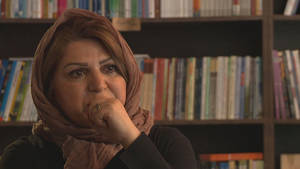Cinema Guild’s latest release of the documentary From Iran: A Separation (2013) explores the intimate significance of Asghar Farhadi’s Oscar-winning A Separation (2011) for the people of Iran: its reception, how its accolades confirmed Iran’s presence in contemporary world cinema, and perhaps most significantly what the Oscar win meant, in a time when there existed the threat of nuclear war between Iran and the United States. By mixing lively talking heads, archival footage, innovative animation techniques, and personal firsthand interviews with local audiences, directors Kourosh Ataee and Azadeh Moussavi explore the importance of A Separation for Iranian people and how its international reception determined representations of a whole nation on the global level.
The film works its way from the production of A Separation, through interviews with the cast and the director, to its Iranian premiere and the way it was received at international festivals. In Tehran, upon its debut, crowds of people extend around blocks waiting for two nights to see A Separation at their local theater. Afterward we have the rare opportunity to hear individual reactions to the film and the differing interpretations that follow. One viewer claims it a realistic portrayal of the Iranian middle class, another a ”confrontation of modernity, tradition, and religion in Iran.” One of the most intriguing exchanges includes an argument between a shop owner and a veiled mother of two on the representation of the norms of Iranian society and Islam in the film. The extent to which individuals, who otherwise seem to have no relation to cinema whatsoever, engage with the film is remarkable, allowing a glimpse into the critical consciousness that appears very much alive in contemporary Iran.
While on the one hand Farhadi’s work was lauded by critics, audiences, and awarding bodies, the documentary equally provides a space to show the converse side, comprising interviews and reactions from those who were scandalized by the film. It is revealed that whole newspapers and executives in Iran turned on A Separation, with its accolades only increasing the hatred for the film in certain corners, leading to verbal attacks on Farhadi and accusations about the involvement of ”Western mafia.” This inclusivity of differing perspectives allows the documentary to bring to light the various kinds of reactions the film evoked and their relation to the immediate sociopolitical climate, specifically the tension and threat of war existing between Iran and the United States.
While relations between the US and Iran have been ”on a collision course since the Iranian revolution in 1979” (see film) the narrator argues how ”the name of Iran was being raised through cinema.” The fact that film is construed as a symbolic space where the relations of political representation are negotiated and, as the public in the film argues, the image of Iran as a peaceful country is propagated, reveals the affective way film can be used in specific sociopolitical contexts. Even if the particular film under debate did not intend to be explicitly political or representative of a nation it becomes so through the subsequent interpretation. A whole nation can be seen sitting in front of their televisions, watching over illegal networks the Academy Awards ceremony and weeping as their country wins the coveted award. Paraphrasing excited Iranians, Farhadi’s Oscar win provided him with a greater platform to promote Iran as a peace-loving nation in a time of possible war than any UN conference or meeting of peace organisations could have. Taking it from this perspective, we can begin to understand the international stature such award ceremonies carry, being determinants of the way cultural orientations and relations between nations are communicated and understood. The documentary interrogates these conceptions and offers new ways for understanding how a film impacts a local audience and how film’s meaning can change depending on the specific political context in which it arises. Cinema Guild’s release of this refined documentary allows a whole new American audience to go “behind the curtain” to experience the Iranian perspective on A Separation, and realize the importance of contextualizing a film and its reception for determining cinema’s role in society.
The filmmakers not only confirm the importance of Farhadi’s A Separation in the Iranian cultural context but more widely illustrate the continuing relevance of cinema in Iran for the ordinary public, situating how Farhadi’s work fits in to the rich body of Iranian cinema history and the conception of Iran both at home and abroad.
Author Biography
Mina Radovic is an undergraduate student of Film Studies and German Language, Literature and Linguistics at the University of St Andrews. He is a filmmaker and also writes regular film critiques for the University Journal and independently. Mina runs an interactive film screening series — under the title “Liberating Cinema” — each semester at the University, and organizes local film events with international filmmakers and academics. His research interests are in archiving, early cinema and film studios, world cinema and, in particular, the links between spectatorship, participation and voyeurism in the cinema of Pier Paolo Pasolini.
Film Details
From Iran: A Separation (2013)
Iran
Directors Kourosh Ataee, Azadeh Moussavi
Runtime 52 minutes
DVD
USA, 2015
Distributed by Cinema Guild








































